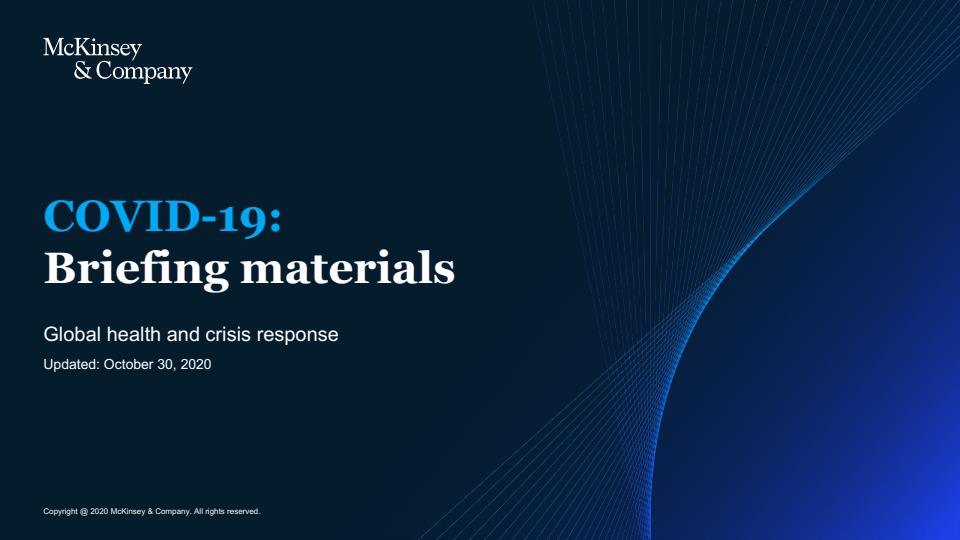
Our latest perspectives on the coronavirus outbreak, the twin threats to lives and livelihoods, and how organizations can prepare for the next normal.
Asia is at an inflection point. New research looks at developments in industrial technology, renewables, travel, ASEAN’s vast human capital, and China’s education system.
In 2020, the largest health and economic crisis in recent history forced companies across sectors into extraordinary measures to protect their people and maintain operations. Did the technologies of the ongoing Fourth Industrial Revolution (or Industry 4.0) help? Our new survey of industrial companies (two-thirds in Asia) suggests three outcomes, starting with a huge win for companies that had already scaled digital technologies (exhibit). Those that were still scaling faced a reality check, and 2020 was a wake-up call for those that hadn’t yet started on their Industry 4.0 journeys.

We strive to provide individuals with disabilities equal access to our website. If you would like information about this content we will be happy to work with you. Please email us at: McKinsey_Website_Accessibility@mckinsey.com
Other technologies are also changing life in Asia. While coal is expected to remain a significant component of India’s energy mix, the country is placing big bets on renewable power, which could make up nearly half of the global total electricity capacity by 2035. Among the biggest believers is Sumant Sinha of ReNew Power. Our interview explores why renewables are different in Asia.
Our 2020 research offered a perspective on the coming rebound in travel: how far, how fast, and where. Now, in an interview with McKinsey, the president of online travel unicorn Traveloka explains the nuts and bolts of the rebound. The critical moves for this company? Giving a thousand employee-volunteers the tools they needed to help customers with more than 150,000 refund requests; extending credit to strapped customers who were having trouble saving for their big trip; and thinking about the local market beyond the big beach destinations popular with international tourists.
For many people, those beaches are a major part of the allure of ASEAN countries, along with sunshine, great food, and history. But as our recent research shows, there is more to ASEAN than just that, and now is a good time to rethink ASEAN and its 650 million people, $3 trillion economy, ten countries, and history of robust growth: 5 percent over the past 20-plus years. In the latest Future of Asia Podcast, our experts delve into the question of whether ASEAN can maintain that track record after the difficult challenges of COVID-19. Short answer: yes, if the region can harness its extraordinary resources.
Across Asia, and the world, work is changing as digitization and automation spread. Hundreds of millions of people may need to raise and refresh their skills; some may need to change occupations. Up to one-third of these transitions may be needed in China. If China gets this right, it could establish a helpful reference point to other economies. The McKinsey Global Institute’s new report looks at the skills revolution that the country needs to keep raising its standard of living.
Also this week, our researchers looked at scenario-based cash planning, the next wave of M&A in advanced industries, lessons from the fastest growing companies in logistics, and the potential for digital and analytics in steel.
With vaccinations underway, executives everywhere are thinking about the critical next months of the pandemic. Start with the McKinsey Download Hub to find McKinsey’s latest research, perspectives, and insights on the management issues that matter most, from leading through the COVID-19 crisis to managing risk and digitizing operations. Also consider our special collection The Next Normal: The Recovery Will Be Digital. The first four installments—a 172-page report on technology and data transformation, a 130-page report on the path to true transformation, a 206-page report on reimagining the postpandemic organization, and a 157-page report on the challenge of climate change—are available now. The final installment is coming as part of Our New Future, a multimedia series we created with CNBC.
You can also see the full collection of our coronavirus-related content, visual insights from our “chart of the day,” a curated collection of our first 100 articles related to the coronavirus, our suite of tools to help leaders respond to the pandemic, and how our editors choose images that help readers visualize the impact of an invisible threat.
No comments:
Post a Comment